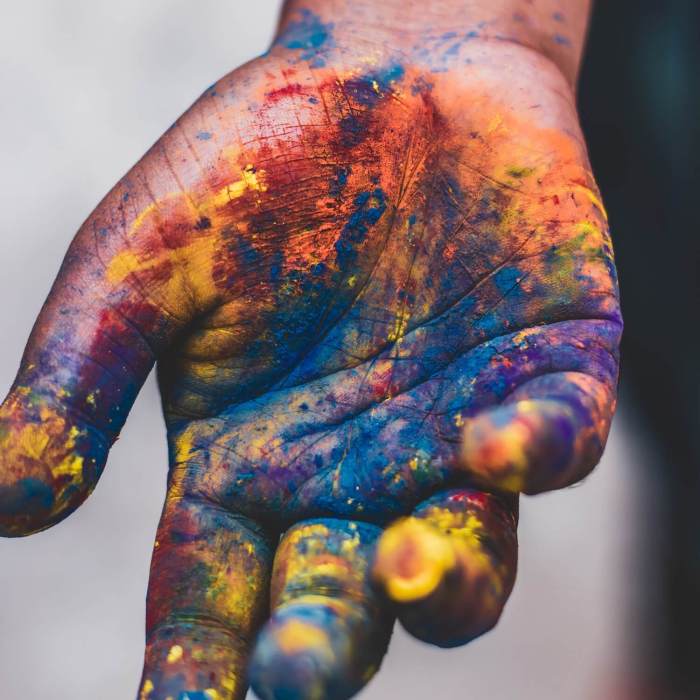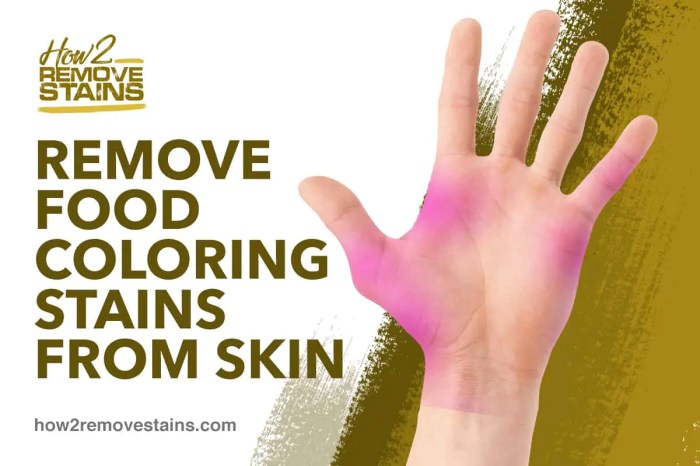Common Methods for Removing Food Coloring from Skin

How to take food coloring off skin – Right, so you’ve got food colouring all over your hands, haven’t you? Proper nightmare, innit? Don’t worry, mate, it happens to the best of us. This ain’t rocket science, and there are loads of ways to sort it out. We’ll run through some dead easy methods you can try at home.
OMG, so I totally messed up and got hot pink food coloring ALL over my hands! It’s, like, a total nightmare. I saw this awesome hot pink food coloring online, but now I need to figure out how to get it off. Seriously, baby oil or even toothpaste works pretty well, but nothing beats a good scrub with soap and water.
Ugh, this stuff is stubborn!
Household Methods for Food Coloring Removal
Here’s the lowdown on some common household items that can help shift that pesky food colouring. Remember, though, always test a small, inconspicuous area first, just in case it reacts weirdly with your skin. Safety first, yeah?
| Method | Ingredients | Procedure | Effectiveness Rating (1-5, 5 being best) |
|---|---|---|---|
| Soap and Water | Mild soap, warm water | Wash the affected area thoroughly with warm water and a mild soap. Gently scrub the area for a minute or two. Rinse with cool water. Repeat if needed. | 3 |
| Baking Soda Paste | Baking soda, water | Mix baking soda with a little water to form a paste. Apply the paste to the stained area and gently rub it in. Leave it for a few minutes before rinsing thoroughly with water. | 4 |
| Baby Oil | Baby oil | Apply a small amount of baby oil to the stained area and gently massage it in. Leave it for a few minutes before wiping it off with a damp cloth. | 3 |
| Toothpaste (Non-gel) | Non-gel toothpaste | Apply a small amount of non-gel toothpaste to the stained area and gently rub it in circular motions. Leave for a couple of minutes then rinse thoroughly. | 4 |
| Rubbing Alcohol (Isopropyl Alcohol) | Rubbing alcohol (70% isopropyl alcohol) | Apply a small amount of rubbing alcohol to a cotton ball or pad. Gently dab the stained area, avoiding harsh rubbing. Rinse with water afterwards. Only use this if other methods fail, and be careful as it can dry out skin. | 5 |
Chemical Properties and Removal Methods
Food colouring, basically, is a mixture of dyes and additives. Different dyes react differently to various cleaning agents. For example, water-based food colourings are often easier to remove with soap and water than oil-based ones, which might need something like baby oil to break them down. Baking soda’s slight abrasiveness helps scrub away the colour, while rubbing alcohol’s solvent properties dissolve the dye molecules.
It’s all about finding the right method to counteract the specific chemical properties of the food colouring used.
Infographic: Three Methods Visualized
Imagine a three-panel infographic.Panel 1: Soap and Water. The panel shows a pair of hands, initially bright red from food colouring, being washed under running water with soap. Bubbles are shown, and the colour gradually fades from the hands in a series of three smaller images within the panel, ending with clean hands. Text underneath reads “Simple and Effective”.Panel 2: Baking Soda Paste.
This panel displays the creation of the paste, showing baking soda and water being mixed. Then, it depicts the application of the paste to stained fingers, and finally, shows the fingers being rinsed clean. The overall colour scheme is calming, using pastel shades. Text underneath reads “Gentle Exfoliation”.Panel 3: Rubbing Alcohol. This panel is more cautionary in tone.
It shows a hand with a small amount of rubbing alcohol applied using a cotton ball, emphasizing the dabbing motion. A warning symbol is subtly incorporated, indicating the need for caution. The final image shows clean hands. The colour scheme uses a more muted palette. Text underneath reads “Powerful, but Use Sparingly”.Each panel has clear, concise instructions, using simple icons and minimal text to ensure easy understanding.
The overall style is clean, modern, and easily digestible, avoiding clutter.
Factors Affecting Food Coloring Removal

Right, so you’ve got food colouring all over your hands, and you’re tryna sort it, yeah? Getting rid of it depends on loads of different things, innit? It’s not just a case of grabbing the first thing you see. Let’s break down what makes a difference.
The effectiveness of getting rid of that pesky food colouring depends on a few key things: what type of colouring it is, how long it’s been chilling on your skin, and what your skin’s like. It’s proper annoying, but it’s true!
Water-Based Versus Oil-Based Food Colorings
Water-based food colourings, like the ones you find in most baking stuff, are generally easier to shift than oil-based ones. Think of it like this: water mixes with water, right? So, soap and water are your best mates here. Oil-based ones, on the other hand, are a bit more stubborn, sticking around longer and needing a bit more elbow grease.
You might need something a bit more powerful to break down that oily gunk.
Stain Age and Removal Effectiveness
The longer that food colouring’s been hanging around, the harder it is to shift. Fresh stains are way easier to deal with; a quick wipe might do the trick. But if you’ve been rocking that vibrant blue hand for a few hours, you’re gonna need to put in a bit more effort, mate. A fresh stain is like a quick clean-up, while an old one is a proper battle!
Effectiveness of Removal Methods Across Different Skin Types
Your skin type also plays a blinder of a role. Oily skin might hold onto the colour longer because the food colouring can get stuck in the oils. Dry skin, on the other hand, might be a bit easier to clean, but can be more sensitive to harsh cleaning products. Sensitive skin needs a gentler approach; you don’t wanna end up with a rash as well as a stain!
| Removal Method | Oily Skin | Dry Skin | Sensitive Skin |
|---|---|---|---|
| Soap and Water | Fairly Effective (for fresh stains) | Effective (for fresh stains) | Effective (for fresh stains, use mild soap) |
| Baby Wipes | Moderately Effective | Moderately Effective | Generally Effective (check for sensitivities) |
| Baking Soda Paste | Effective (may need more scrubbing) | Moderately Effective (avoid over-scrubbing) | Use with caution, may cause irritation |
| Rubbing Alcohol | Effective (but can dry out skin) | Use with caution, can dry out skin | Avoid, can cause irritation |
| Makeup Remover | Moderately Effective | Moderately Effective | Generally Effective (check for sensitivities) |
Advanced Techniques for Stubborn Stains

Right, so you’ve tried the usual stuff – soap and water, maybe a bit of scrubbing – and that pesky food colouring’s still clinging on like a limpet? Don’t panic, mate. There are some proper boss-level techniques you can try to banish those stubborn stains. We’re talking about methods that are a bit more intense, so remember to always patch test on a small, inconspicuous area first, innit?
These advanced methods can be more effective than basic cleaning, but they also carry slightly more risk of irritating your skin or damaging fabrics. Always follow instructions carefully and, if in doubt, get a grown-up to help!
Baking Soda Paste, How to take food coloring off skin
A baking soda paste is a total lifesaver for loads of cleaning jobs, and food colouring is no exception. Mix baking soda with a little water to create a paste – think toothpaste consistency. Gently apply the paste to the stained area and leave it for a few minutes to work its magic. Then, gently scrub the area with a soft cloth or toothbrush and rinse thoroughly with water.
The baking soda acts as a mild abrasive, helping to lift the food colouring from the skin. It’s generally pretty safe, but if you’ve got sensitive skin, you might want to give it a miss or do a quick patch test first.
Dish Soap and Hydrogen Peroxide Mixture
This combo is a proper power move against stubborn stains. Mix a small amount of dish soap with an equal amount of hydrogen peroxide (the 3% kind you get from the chemist). Apply this mixture to the stained area and gently rub it in. Leave it for a few minutes, then rinse thoroughly. Hydrogen peroxide is a bleaching agent, so it’s mega-effective at lightening stains, but it can also irritate skin, so be careful, and don’t leave it on for ages.
Also, avoid getting it in your eyes, obviously. This method is definitely more effective than just using soap and water alone, but it’s not suitable for everyone, especially those with sensitive skin.
Comparing these advanced methods to simpler ones, you’ll find that the baking soda paste is gentler, while the dish soap and hydrogen peroxide mix packs a much more powerful punch. The baking soda is a good starting point for persistent stains, while the peroxide mix should be reserved for those truly stubborn marks that just won’t budge. Always consider your skin type and the sensitivity of the stained area before choosing your weapon.
Remember, safety first! Always test any new cleaning method on a small, hidden area before applying it to the whole stained area. If you experience any irritation or discomfort, stop using the method immediately and rinse thoroughly with water. If the stain persists despite your best efforts, it might be time to seek professional help or just accept defeat and rock that food-coloured look!
FAQ Insights: How To Take Food Coloring Off Skin
What if food coloring gets in my eye?
Immediately flush your eye with plenty of cool water for at least 15 minutes. Seek medical attention if irritation persists.
Is it safe to use bleach to remove food coloring?
No, bleach is too harsh for skin and can cause irritation or damage. Stick to gentler methods.
My child ingested some food coloring. What should I do?
Contact your doctor or poison control immediately. The amount ingested and the child’s age will determine the appropriate course of action.
Can I use rubbing alcohol on sensitive skin?
Rubbing alcohol can be drying and irritating to sensitive skin. Test a small area first before applying it widely.
